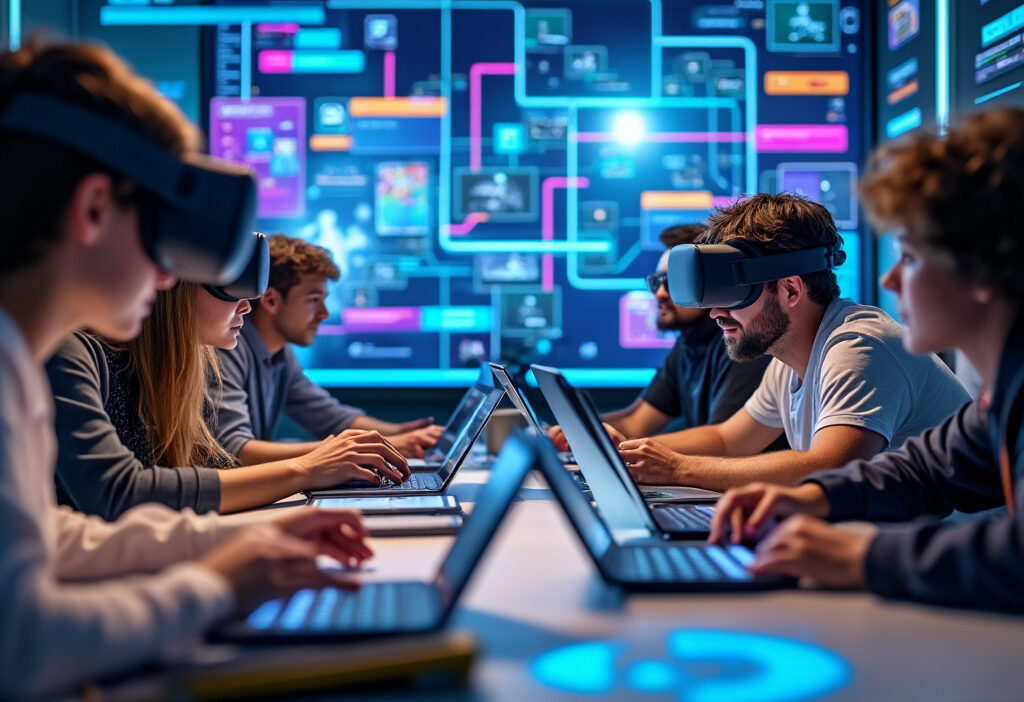Lifelong Learning in the Digital Age: How EdTech Platforms Are Empowering Continuous Growth in 2025
The transformation of lifelong learning in 2025 is marked by innovative EdTech platforms, making learning more accessible and personalized. These platforms leverage cutting-edge technologies to support continuous growth, creating a nurturing environment for both personal and professional development.
The Evolution of Lifelong Learning
The concept of lifelong learning has evolved dramatically over the centuries, shifting from informal apprenticeships and oral traditions to structured institutional education. In the 20th century, formal education became the primary vehicle for skill acquisition, but its rigid frameworks often failed to accommodate the diverse needs of adult learners. The digital revolution of the early 21st century disrupted this paradigm, introducing flexible, on-demand learning opportunities that transcended geographical and temporal barriers.
By 2025, lifelong learning is no longer a luxury but a necessity, driven by rapid technological advancements and shifting labor markets. Traditional classroom-based models have given way to personalized, adaptive learning ecosystems, where artificial intelligence tailors content to individual progress and preferences. Microlearning modules, gamification, and immersive experiences through augmented and virtual reality have redefined engagement, making learning more accessible and enjoyable.
EdTech platforms now serve as the backbone of this transformation, offering:
- Just-in-time upskilling: Professionals can acquire new competencies in real-time, aligning with industry demands.
- Decentralized credentialing: Blockchain-powered certifications validate skills without traditional academic gatekeeping.
- Community-driven knowledge sharing: Peer-to-peer learning networks foster collaboration across borders.
The shift from passive consumption to active participation has democratized education, enabling learners from all backgrounds to continuously adapt and thrive. As technology blurs the line between formal and informal learning, the future of lifelong education lies in seamless integration—where every digital interaction becomes a potential learning opportunity. The next chapter will delve deeper into how EdTech platforms harness interdisciplinary approaches to make this vision a reality.
Understanding Educational Technology (EdTech)
Educational Technology (EdTech) represents the convergence of pedagogy, cognitive science, and cutting-edge digital tools to create dynamic learning ecosystems. Unlike traditional education models, EdTech leverages interdisciplinary insights—from behavioral psychology to data analytics—to craft immersive, scalable, and adaptive learning experiences. In 2025, EdTech platforms are no longer just repositories of content but intelligent systems designed to foster continuous growth, aligning with the evolving demands of lifelong learners.
At its core, EdTech integrates multimodal learning—combining video, interactive simulations, gamification, and social learning—to cater to diverse cognitive preferences. Platforms like Coursera, Udacity, and emerging decentralized learning networks employ microlearning techniques, breaking complex subjects into digestible modules that fit into busy lifestyles. These systems also harness real-time analytics to provide learners with instant feedback, a feature rooted in formative assessment theories, ensuring knowledge gaps are addressed proactively.
The development of EdTech has been propelled by advancements in cloud computing, AR/VR, and collaborative tools, enabling global peer-to-peer learning. For instance, virtual labs allow learners to conduct experiments remotely, while AI-driven discussion forums foster critical thinking. Importantly, EdTech’s scalability democratizes access, bridging gaps for underrepresented communities through low-bandwidth solutions and multilingual support.
As we transition from the historical context of lifelong learning to its AI-driven future, EdTech serves as the backbone, merging theoretical rigor with technological innovation. It doesn’t just deliver content—it cultivates self-directed learning, empowering individuals to curate their educational journeys in alignment with personal and professional aspirations. The next chapter will explore how AI refines this further, tailoring pathways to individual needs.
AI and Personalized Learning Pathways
Artificial Intelligence (AI) has revolutionized lifelong learning by transforming static educational models into dynamic, adaptive experiences. Unlike traditional EdTech platforms that deliver standardized content, AI-driven systems analyze vast datasets—including learning behaviors, preferences, and performance metrics—to create personalized learning pathways. By leveraging machine learning algorithms, these platforms adjust content difficulty, recommend resources, and even predict knowledge gaps before they hinder progress.
One of the most significant advancements is AI’s ability to curate hyper-personalized curricula. For instance, if a learner struggles with a specific concept in data science, the system can detect this through interaction patterns and automatically introduce supplementary materials, such as interactive exercises or micro-lessons. Conversely, if a learner demonstrates mastery, the AI accelerates their progression, ensuring time isn’t wasted on redundant material.
Beyond content adaptation, AI enhances engagement through real-time feedback loops. Natural Language Processing (NLP) enables chatbots and virtual tutors to provide instant, context-aware assistance, mimicking one-on-one mentorship. Meanwhile, predictive analytics help learners visualize their growth trajectories, fostering motivation by aligning goals with achievable milestones.
The integration of AI also addresses accessibility. Adaptive interfaces cater to diverse learning styles—auditory, visual, or kinesthetic—while speech recognition and translation tools break language barriers. In 2025, these capabilities are no longer experimental but foundational, making lifelong learning more inclusive and efficient.
As we transition to immersive technologies like VR/AR, AI remains the backbone, ensuring that personalized learning isn’t just reactive but anticipatory—preparing learners for future challenges by continuously evolving alongside them.
The Rise of Immersive Learning Experiences
The Rise of Immersive Learning Experiences
Building on the personalized pathways enabled by AI, immersive technologies like Virtual Reality (VR) and Augmented Reality (AR) are revolutionizing lifelong learning by creating deeply engaging, experiential environments. Unlike traditional methods, VR/AR allows learners to interact with content in three-dimensional spaces, bridging the gap between theory and practice. For instance, medical students can perform virtual surgeries, while engineers can troubleshoot machinery in a risk-free simulation. These hands-on experiences not only improve retention but also cater to diverse learning styles—visual, auditory, and kinesthetic—making education more inclusive.
The power of immersion lies in its ability to replicate real-world scenarios. A language learner can practice conversations with AI-driven avatars in a virtual Paris café, while a history enthusiast might walk through ancient Rome, witnessing events unfold. Such contextual learning fosters deeper understanding and emotional connection, which are critical for long-term knowledge retention. Platforms like EngageXR and Mozilla Hubs are democratizing access to these tools, enabling learners worldwide to collaborate in shared virtual classrooms.
Moreover, VR/AR complements AI-driven personalization by adapting environments to individual progress. If a learner struggles with a concept, the system can dynamically adjust the scenario, offering additional cues or simplifying tasks. This synergy between immersion and AI ensures that education remains responsive and effective. As these technologies become more affordable and accessible, they are poised to redefine lifelong learning, making it not just informative but transformative. The next frontier? Gamification, which leverages these immersive experiences to further boost motivation and engagement.
Gamification and Its Role in Engagement
Building on the immersive experiences enabled by VR/AR, gamification in EdTech platforms has emerged as a powerful tool to sustain learner motivation and engagement in 2025. Unlike passive consumption of content, gamification leverages psychological triggers—such as competition, achievement, and instant feedback—to make continuous learning feel dynamic and rewarding. By integrating elements like badges, leaderboards, and progress tracking, platforms transform education into an interactive journey rather than a static obligation.
One key innovation is the use of adaptive gamification, where algorithms personalize challenges based on a learner’s pace and preferences. For instance, language apps now adjust difficulty levels in real-time, offering bonus points for mastering complex grammar or maintaining streaks. Meanwhile, professional upskilling platforms employ scenario-based simulations where users earn virtual currency for solving real-world business problems—bridging the gap between theory and practice.
Social gamification has also gained traction, fostering communities where learners collaborate or compete. Platforms like Coursera and Duolingo incorporate team-based quests, turning solitary study into a shared mission. Research shows that learners in gamified environments exhibit 30% higher completion rates, as the dopamine-driven feedback loops mimic the gratification of gaming.
However, the success of gamification hinges on balancing fun with educational value. Overemphasis on rewards can overshadow deep learning, so leading platforms now blend game mechanics with meaningful milestones, such as skill certifications or peer recognition. As microlearning (explored next) gains prominence, gamified micro-modules—like daily trivia or 5-minute challenges—are proving ideal for maintaining engagement in our fast-paced world.
By making learning addictive in the best sense, gamification ensures that education in 2025 isn’t just immersive or flexible—but irresistibly engaging.
Microlearning: Adapting to Modern Lifestyles
In today’s fast-paced world, where time is a scarce commodity, microlearning has emerged as a game-changer for lifelong learners. Unlike traditional educational models that demand extended focus, microlearning breaks knowledge into bite-sized, easily digestible modules—typically under 10 minutes—allowing learners to absorb information without overwhelming their schedules. This approach aligns perfectly with modern lifestyles, where multitasking and on-the-go learning have become the norm.
EdTech platforms in 2025 leverage AI-driven personalization to curate microlearning content tailored to individual needs. Whether it’s a quick video tutorial, an interactive quiz, or a flashcard-based review, learners can engage with material at their convenience, reinforcing retention through spaced repetition. Studies show that microlearning improves knowledge retention by up to 20% compared to traditional methods, as it aligns with the brain’s natural cognitive processing.
The flexibility of microlearning also complements the engagement strategies discussed in gamification. While gamification motivates through rewards, microlearning ensures that progress remains frictionless—learners can pick up where they left off, even during a commute or a lunch break. Moreover, this method seamlessly integrates with hybrid learning models, where digital and in-person experiences converge. Short, focused lessons can serve as pre-work before deeper discussions in offline settings, bridging the gap between self-paced and collaborative learning.
As workplaces and personal lives grow increasingly dynamic, microlearning stands out as a scalable, efficient solution for continuous upskilling. By meeting learners where they are—both in time and attention—EdTech platforms ensure that education remains accessible, adaptable, and aligned with the demands of the digital age.
Hybrid Learning Models: The Best of Both Worlds
Hybrid learning models have emerged as a transformative force in education, blending the flexibility of digital platforms with the engagement of in-person experiences. In 2025, these models are no longer just a response to pandemic-era constraints but a deliberate strategy to enhance learning outcomes. By integrating synchronous and asynchronous elements, hybrid learning caters to diverse preferences, ensuring accessibility without sacrificing depth or interaction.
Key advantages of hybrid learning include:
- Personalized pathways: Learners can choose between live sessions for real-time collaboration or recorded modules for self-paced study, adapting to their unique rhythms.
- Enhanced resource access: Digital libraries, virtual labs, and global expert talks complement traditional classroom materials, breaking geographical and logistical barriers.
- Data-driven adaptability: AI-powered analytics track engagement and performance, allowing educators to tailor content dynamically—addressing gaps while reinforcing strengths.
The hybrid model also bridges the gap between microlearning’s efficiency and the need for deeper, structured knowledge. While microlearning excels in delivering bite-sized skills, hybrid frameworks provide the scaffolding for long-term mastery, connecting isolated concepts into cohesive understanding. Institutions now leverage immersive technologies like AR and VR to simulate hands-on experiences remotely, ensuring practical skills aren’t compromised in digital environments.
As lifelong learning becomes standard (as explored in the next chapter), hybrid models offer a sustainable framework. Professionals can attend evening workshops in person while accessing supplementary modules online, aligning upskilling with busy schedules. This duality ensures continuous growth isn’t just aspirational but actionable, meeting the demands of an evolving workforce where adaptability is paramount.
Lifelong Learning as Standard Practice
The rapid evolution of technology and shifting job demands have made lifelong learning an essential practice rather than an optional pursuit. In 2025, the concept of continuous education has become deeply embedded in both personal and professional development, driven by the need to stay relevant in a dynamic workforce. EdTech platforms have played a pivotal role in normalizing this shift, offering flexible, on-demand learning opportunities that cater to diverse needs—whether for career advancement, personal enrichment, or industry transitions.
Organizations now recognize that fostering a culture of perpetual learning is not just beneficial but necessary for competitiveness. Companies are integrating learning pathways into employee development programs, leveraging AI-driven recommendations to personalize upskilling journeys. Meanwhile, individuals are taking ownership of their growth, using platforms that provide bite-sized courses, interactive simulations, and real-world projects to build competencies at their own pace.
Societal expectations have also shifted. The stigma around mid-career education has faded, replaced by an appreciation for adaptability. Governments and institutions are supporting this trend through policies that incentivize continuous education, such as tax breaks for skill-building expenses or partnerships with EdTech providers. The result is a workforce that views learning as an ongoing process rather than a one-time milestone.
As hybrid learning models have expanded access, lifelong learning has become more seamless, bridging gaps between formal education and real-world application. The next frontier lies in digital badges and microcredentials, which offer tangible proof of these efforts—a topic explored in the following chapter. Together, these advancements reinforce the idea that in the digital age, growth is not finite but a lifelong journey.
Digital Badges and Microcredentials
In today’s fast-paced digital economy, traditional degrees alone no longer suffice to demonstrate expertise. Digital badges and microcredentials have emerged as powerful tools for validating skills, offering granular proof of competency in specific areas. Unlike broad qualifications, these credentials focus on precise, in-demand abilities—ranging from AI programming to digital marketing strategies—enabling learners to showcase their proficiency in a modular, stackable format.
Employers increasingly recognize these credentials as reliable indicators of practical skills. Platforms like Coursera, Udacity, and LinkedIn Learning partner with industry leaders to design microcredentials that align with real-world job requirements. For instance, a Google Data Analytics Certificate or an AWS Cloud Practitioner badge carries weight because it reflects hands-on, role-specific knowledge. This shift has blurred the lines between formal education and professional development, allowing individuals to tailor their learning paths to career goals.
Higher education institutions are also embracing microcredentials, embedding them into degree programs or offering standalone certifications. Universities like MIT and Stanford now provide digital badges for completing specialized courses, bridging gaps between academia and industry needs. Meanwhile, blockchain technology ensures these credentials are tamper-proof and easily verifiable, enhancing their credibility.
For professionals, microcredentials offer agility. Instead of committing to lengthy programs, learners can acquire targeted skills in weeks or months, staying competitive in dynamic fields. This flexibility is particularly valuable for career changers or those in rapidly evolving sectors like cybersecurity or renewable energy.
As lifelong learning becomes the norm, digital badges and microcredentials serve as the currency of skill validation, empowering individuals to navigate career transitions with confidence and precision. Their growing acceptance signals a future where continuous growth is both measurable and marketable.
The Future of Lifelong Learning
The rapid evolution of EdTech platforms in 2025 has transformed lifelong learning from an aspirational goal into an everyday reality. No longer confined to traditional classrooms or rigid curricula, education has become a fluid, personalized experience, seamlessly integrated into professional and personal lives. With AI-driven adaptive learning systems, immersive VR environments, and collaborative online communities, these platforms are breaking down barriers—geographic, financial, and cognitive—making knowledge acquisition more inclusive than ever before.
One of the most significant shifts is the move from passive consumption to active co-creation of knowledge. Learners no longer just absorb content; they engage in problem-solving simulations, contribute to peer-reviewed projects, and even shape course material through feedback loops. Platforms like Coursera, Udacity, and newer decentralized learning networks leverage blockchain to verify skills transparently, ensuring that achievements—whether microcredentials or full degrees—are portable and universally recognized.
The democratization of learning is further amplified by affordability. Subscription models, pay-as-you-go courses, and employer-sponsored upskilling programs ensure that cost is no longer a prohibitive factor. Meanwhile, AI-powered mentors provide real-time guidance, adapting to individual pacing and learning styles. This hyper-personalization ensures that whether a learner is a mid-career professional pivoting industries or a retiree exploring new passions, the tools for growth are at their fingertips.
As the digital and physical worlds continue to merge, lifelong learning becomes less about checking boxes and more about continuous evolution. The future belongs to those who embrace this mindset, leveraging EdTech not just for career advancement but for holistic personal development. In 2025, learning isn’t a phase—it’s a way of life.

Conclusions
In 2025, EdTech platforms are revolutionizing lifelong learning, making it more effective and accessible. By integrating AI, VR/AR, and microlearning, these platforms support continuous personal and professional growth. Lifelong learning has evolved from a concept into a daily practice, ensuring individuals remain competitive and adaptable in a dynamic digital world.



